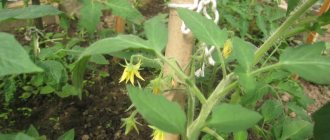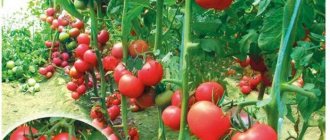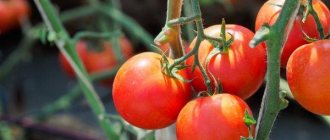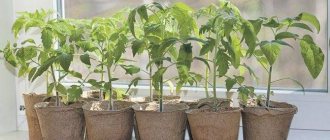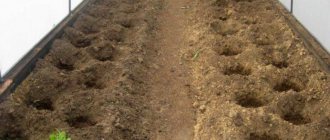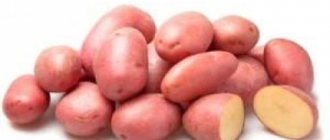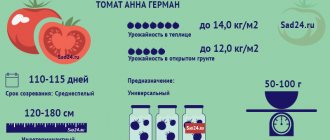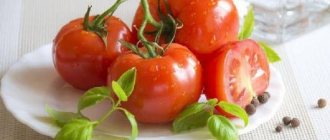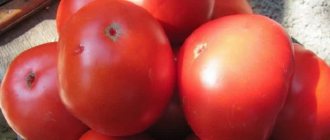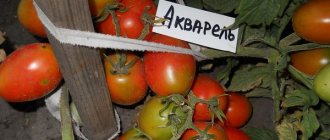Characteristics of tomatoes Kemerovo
The Kemerovo variety has early ripening periods (they range from 102 to 107 days). This plant is a determinate type tomato. The bush is a standard bush, formed into one stem. The height is no more than 50 cm.
The stem and leaves of the tomato are dark green in color. The foliage of the bush is low, the shape of the leaves is standard for a tomato - they are unpaired and dissected into relatively large lobes. Leaves size is up to 7 cm in length.
The flowers are small, yellow, collected in raceme-type inflorescences of up to 20 pieces. Approximately 80% of flowers set. Almost all of them form fruits at the same time.
The fruits of the Kemerovets variety are heart-shaped with slight ribbing. The weight of the fruit can vary from 55 to 105 g. There are individual large specimens up to 200 g, the largest recorded fruit weighed under 300 g. The color of unripe fruits is light green, when fully ripe it is red-crimson. A special feature of Kemerovo is that about half of the fruits have a small spout.
The Kemerovo tomato has many positive reviews from gardeners, since it has an acceptable yield for its growing conditions (up to 20 kg per 1 sq. m). A cross-sectional photo of Kemerovo tomato fruits is presented below:
Agricultural technology
Growing Lady Claire potatoes is easy. You need to follow the usual technique for planting vegetables. However, it is also necessary to take into account some nuances inherent in the variety.
Lady Claire seed potatoes are best purchased in specialized stores or trusted farms. Before buying a product, the gardener must familiarize himself with the quality certificate. This document contains information about the characteristics of the variety, batch data, and supplier contacts. The certificate indicates the reproduction, that is, the stage of propagation of potatoes. It is best to choose the elite. Part of the harvest from such root crops can be continuously used for planting on the site for 4-5 years without renewal.
Lady Claire is unpretentious to the soil. But it grows best on loose black soil with a sufficient amount of sand. It is recommended to plant in central Russia in open ground. In the north, planting in greenhouses is allowed.
Planting potatoes
The variety is prepared before planting. Tubers are pickled with a manganese solution. Then they germinate for a month in the light in a room where it is +11…+15 degrees. Lady Claire potatoes are not recommended to be cut. It is best to plant whole tubers.
The potato plot is being dug up. Remove weeds and roots. Fertilize with humus and compost. Planting takes place as soon as the soil warms up to +10 degrees to a depth of 15 cm. The distance between tubers is 30-40 cm. Between rows is 60 cm. Potatoes are planted in the ground to a depth of no more than 8-10 cm. This is approximately the height of a spade bayonet . The variety cannot be planted deep because the tubers can rot in the ground. Along with the potatoes, ash and onion peels are placed in the ground.
Caring for potatoes consists of weeding, hilling, watering, and fertilizing. Potatoes need to be weeded every 15-20 days. Hilling takes place twice per season. The first time, as soon as the bushes stretch up to 10 cm. The second time - in a month. Potatoes do not like waterlogged soil, but they also cannot tolerate prolonged drought. Watering is carried out taking into account hot weather. If it rains periodically, you don’t have to water the potatoes. If it is hot outside, then it is enough to moisten the soil once every 10 days.
Additional Information. It is necessary to feed potatoes only if they grow in poor soil. Fertile soil does not need to be fertilized. To feed potatoes, you can use mixtures based on potassium and phosphorus.
Description of tomato Goldfish
An indeterminate shrub without limiting the end point of growth belongs to the mid-late varieties. From the moment young tomato shoots sprout until the first harvest, 3.5 months pass, in open ground 10–14 days later. “Goldfish” tomatoes can be grown in greenhouse structures in the Urals, Far East, and Siberia. In areas with warm climates, tomatoes have time to ripen without additional shelter.
External description of the tomato variety “Goldfish”:
- The main stem is not stable, it is not thick and powerful enough to withstand the weight of ripe tomatoes without additional support.
- It reaches a height of two meters; in a greenhouse, the top of the tomato is broken at a level of 1.5–1.7 m; the maximum height of the variety in open ground is 110–120 cm.
- In a greenhouse, a tomato is formed with one, often two, trunks in an unprotected area, using 3–4 stems.
- The variety has high foliage, the leaves are narrow, elongated, dark green, with a large number of small carved fragments at the end. The resemblance of the leaves to the caudal fin of a fish and the beautiful color of the fruit gave the corresponding name to the tomato.
- The flowers of the “Goldfish” tomato are yellow, collected in simple inflorescences, and in 90% of cases they produce ovaries. The clusters are long, the first growth begins at the height of the eighth leaf, the subsequent ones are laid after 3. The average fruiting capacity is 5–7 fruits.
Description of fruits
Goldfish tomatoes can be classified as exotic species due to their unusual color, which is unusual for traditional representatives of the nightshade culture:
- the first ripe tomatoes are a rich, bright yellow color with a slight orange tint, becoming a shade lighter towards the end of the growing season;
- the weight of the fruits of this variety varies from 220 g on the lower circle to 130 g on subsequent clusters;
- the shape of an elongated oval (plum-shaped) at the end with a pronounced process, the so-called spout;
- pulp of dense consistency, juicy, sweet with no acid;
- the seeds of the variety are large, beige in color, located in 4 chambers;
- the peel is thin, glossy, durable, and not prone to cracking.
The tomato owes its color to the high concentration of carotene in its biological composition.
Harvest formation
Uzbek fruits have average yield. If growing conditions favorably affect vegetables, then they can produce much more yield than usual. The ovaries must be constantly formed. The plant also loves sun and warmth. Watering is carried out quite often. It is necessary to control the appearance of stepsons and remove them immediately, since they take all the nutrients from the plant.
Yusupov fruits are planted far from each other. The plant needs a lot of sun and wind from all sides. Closer to frost, tomatoes are picked and do not wait until they are fully ripe. Of course, due to early failure, the taste will not be as rich, but they will completely die from frost.
Varieties for pickling
This category includes varieties with small fruits that have a dense skin that protects them from cracking during heat treatment. Pickling non-sapling tomatoes are distinguished by uniform yield. The average weight of each tomato is no more than 100 g. This allows the whole fruit to be placed in jars.
- Salting miracle. The compact bush (70-80 cm) does not need to remove stepsons. Fleshy, oval-shaped fruits ripen on clusters of 10-12 pieces. The harvest ripens after 3 months. Ripe tomatoes with thick skin can withstand transportation without loss. The pickling miracle is characterized by high immunity to disease and is resistant to temperature fluctuations. Smooth, plum-like fruits grow weighing up to 100 g.
- Lady fingers. A cylindrical shaped variety of non-grafting tomato. Rapid fruit ripening helps avoid late blight. Bushes 60 cm high are strewn with tomatoes, collected in brushes of 5-6 pieces. The pulp is tasty with a small number of seeds. It is grown mainly in open ground.
- Barnaul canning. An early variety resistant to low temperatures. Ripening occurs in 95-105 days. Round, orange-red cocktail-type tomatoes do not exceed 50 g in weight. The spreading bush requires tying up, otherwise the fruits will lean towards the ground. According to gardeners, the variety is ideal for home harvesting.
- Pepper. A very productive and undemanding variety, the fruits of which are intended for whole-fruit pickling. It is grown without support in open beds in the conditions of the middle zone, Siberia and the Urals. Smooth, elongated tomatoes with a miniature nose ripen in 3-3.5 months. The pulp and peel are bright red.
- Pickle. The determinate variety is recommended for open ground. Even in unfavorable weather conditions, the bush bears a large number of fruits. Hands loaded with ripening tomatoes require timely garter. Smooth, round tomatoes grow up to 70 g. The ripe pulp is red in color and has a pleasant taste.
Pickling varieties of tomatoes without pinching, as a rule, are distinguished by keeping quality. The thick skin facilitates long-term storage without loss of presentation.
Advantages and disadvantages
Advantages of the Shedi Lady hybrid:
- resistance to adverse weather conditions (heat, sudden temperature changes);
- immunity to nightshade viral diseases;
- possibility of transportation over long distances without loss of commercial qualities;
- dense skin, not prone to cracking;
- wonderful taste;
- possibility of ripening outside the bush;
- high yield.
The only disadvantages include the need for pinching and the formation of a bush with 2 stems to obtain large harvests.
Growing seedlings
You can buy seedlings or grow them yourself
In order to get a well-developed and healthy adult plant, you need to take proper care of the seedlings. You can purchase seedlings in nurseries or from trusted gardeners, but you can only be completely confident in the planting material if you take on this task yourself.
Planting seeds
Since the plant is a representative of mid-late varieties, the seeds are planted at the end of February
Particular attention should be paid to the choice of planting material. It is worth giving preference to trusted manufacturers, or collecting seeds from the largest and healthiest fruits yourself.
The seeds are planted in a mixture of peat, humus and soil. Such a substrate will give the opportunity to grow and develop young shoots that are in dire need of nutrients. Before planting, the soil is well moistened, and the seeds themselves are soaked for 2-3 hours in a weak solution of potassium permanganate.
Sprout care
After the first shoots appear, the seedling box must be placed in a warm, well-lit place
It is important to remember to maintain comfortable air humidity. If the humidity is low, and this may happen near heating devices, it is necessary to water the seedlings more often
The lack of light and short daylight hours can be compensated for with special ultraviolet lamps.
When growing tomato seedlings, you need to remember that:
- Young shoots are very tender and can be easily injured and even burned from direct sunlight.
- Tomatoes grow quickly and reach for the light. In order for the plant to form correctly, you need to turn the pot towards the light source in different directions.
- Soil taken from the garden may be contaminated with fungal spores or parasite eggs, so before use it is calcined or watered with a manganese solution.
When 3-4 true leaves appear on the shoot, it is picked and planted in separate pots or cups. There it will grow until transplanted to a permanent location.
Transplanting
When the seedlings reach 50-60 days of age and the threat of return frosts disappears, the tomatoes are planted in a permanent place. This can be an open bed or a film shelter. The variety is hardy and bears fruit well under any planting option.
Since the tomato is very tall, it is worth taking this into account when growing it in greenhouse conditions. Bushes are planted at a distance of 40-50 cm from each other. No more than 5 plants should be placed per 1 m².
In the spring, humus, potassium and phosphorus fertilizers are added to the soil where the tomatoes will grow while digging. This can also be done immediately before planting, placing fertilizer directly into the hole. But you should be careful with humus, it must rot well, otherwise the tomato roots will simply “burn.”
Fertilizer
The plant needs feeding
It is necessary to fertilize the crop not only during planting, but also throughout the entire growing season. 2 weeks after planting the seedlings, you can carry out the first feeding. By this time, the plant has taken root well and can obtain the necessary substances from the soil.
Subsequent applications of fertilizers occur at the beginning of plant flowering and the period of fruit ripening. The bush is watered at the root with water containing potassium, phosphorus-containing and sodium fertilizers diluted in it.
Among other things, many summer residents practice feeding nettle crusts and other weeds. To do this, the green mass is soaked in a barrel or flask and left to ferment for 10-14 days. The resulting slurry is diluted in water and watered at the root of the plant.
Watering
Water tomatoes early in the morning or in the evening. At this time, there is no sweltering heat, and the liquid does not evaporate from the soil surface too quickly. Due to the fact that tomatoes can crack from excess moisture, you should not overwater the plants. Such watering can also provoke the development of late blight.
The water must be heated before watering. You can't pour directly from the well. Such a sharp temperature change harms the roots and contributes to the development of root rot.
Large-fruited varieties
Productivity is one of the important indicators that gardeners take into account. Despite the fact that the varieties that do not require pinching are generally inferior in the number of ovaries and the size of the fruits to their tall counterparts, breeders were able to develop a number of varieties that make it possible to obtain up to 8-9 kg of tomato per 1 m2.
- Altaechka. The variety produces a harvest after 3 months, before late blight appears. The height of the bush in garden beds does not exceed 70 cm, in greenhouse conditions - 90 cm. The fruits weigh up to 300 g, have a rich scarlet color of the peel and pulp. When planting 4 bushes per 1 m2 and following agricultural technology, the yield reaches 8 kg.
- Standard large-fruited. Refers to mid-season varieties that do not require support. Compact bushes grow just over half a meter in height. The weight of an average tomato is about 350 g. Larger specimens, weighing 500 g, ripen on the lower cluster. Ripe vegetables are used for salads and making juice. It is recommended to grow in open beds with dense planting (40 cm between bushes).
- Tamara. A variety for growing under film or in open ground. The harvest ripens in 110 days. It is valued for the high taste qualities of ripe tomatoes, weighing about 300 g. Up to 6 kg of fruits are harvested from each bush, while the height of the plant is only 80 cm. The disadvantage of the variety is susceptibility to root rot, powdery mildew and early wilting. Agricultural technology must necessarily include the prevention of these diseases.
- Tasmanian chocolate. Ripening occurs after 85 days. The bush is densely covered with dark green foliage. The flattened fruits have a red-brown skin color and a lighter flesh color. The yield is 8-9 kg per plant with a fruit weight of 250-350 g. Suitable for greenhouses, grows well in open ground in central Russia.
Large-fruited varieties need to be provided with garters so that the branches do not break under the weight of filling tomatoes.
Features of the variety
The characteristics and description of the “Iron Lady” tomato variety will satisfy the needs of many Russian summer residents, because the plant is a mid-season variety that is intended for growing in open ground, as well as under film-type shelters.
The Iron Lady F1 variety refers to early ripening hybrids that, after planting, produce a harvest in 100-115 days.
The bushes are not too tall (up to 110 cm), with powerful, wide foliage. It protects the plant from drying out. The leaves are large and green. The inflorescence has a flat shape, with a stalk without articulation. The first inflorescence appears above the 7th leaf, the next one is formed after 1-2 leaves.
Tomatoes are located on the bushes in small clusters, up to 10-12 pieces. The tomato variety has high yields. You can get up to 7-8 kg per square meter.
Important! Many housewives love this tomato variety not only for its high yield, but also for the peculiarity of its pulp. Even when stored it is not watery.
The fruits of the crop are intended for preparing salads and canning. Housewives especially like to use the fruits of this variety for whole-fruit canning, since the peel is dense and rarely cracks. The average weight is approximately 60-80 grams. The fruits are round, slightly plum-shaped, the pulp is very juicy, sugary, with high taste. Unripe fruits are green, and when ripe they turn bright red.
Features of cultivation
Seeds for seedlings are sown in early March. Light and nutritious soil is used from a mixture of turf or garden soil with rotted humus.
Seeds are soaked in a growth stimulant before planting. Treatment with disinfectant solutions is not necessary; seeds undergo all procedures before packaging and sale.
The seeds are sown at a depth of 2 cm, sprinkled with peat on top and sprayed with warm water. The plantings are covered with film and placed in a warm place. You can use special mini-greenhouses. After germination, the container is exposed to bright light: the windowsill of a south-facing window, or under electric lamps. From time to time the container needs to be rotated to ensure uniform development of the seedlings.
Picking into separate pots is carried out after unfolding 2 true leaves. After picking, young plants are fed with liquid complex fertilizer. Planting for permanent residence occurs as follows: seedlings are planted in film greenhouses in early May. Plants are moved to the beds towards the end of the month and covered with film in the first days.
It is important that the soil warms up completely! Before planting, the soil is thoroughly loosened. Add 1 tbsp to each well
spoon of complex fertilizers or wood ash. Read here how to prepare soil in a greenhouse in spring. Watering is moderate, only warm water is used. Cold weather can cause shock and slow down the growth of bushes.
Before flowering begins, it is possible to use nitrogen-containing fertilizers; after the formation of ovaries, it is recommended to focus on potassium and phosphorus. Mineral fertilizers can be alternated with organic ones, but you should not get too carried away with organics. Mullein and bird droppings contribute to the accumulation of nitrates in fruits.
The following are also used as fertilizers:
- Yeast.
- Iodine.
- Ash.
- Hydrogen peroxide.
- Ammonia.
- Boric acid.
Read on our website: How to get an excellent harvest of tomatoes in open ground? How to grow tomatoes all year round in a winter greenhouse?
How to properly care for early ripening varieties? Which tomatoes are the highest yielding and most disease resistant?
Description of the Shady Lady tomato and recommendations for growing a hybrid variety
Shedy Lady is a tomato that is characterized by early ripening and high yield. Owners of summer cottages pick the first fruits 2 months after planting the crop. The designation F1 in the variety name indicates that the tomato is a first generation hybrid. Tomato Shady Lady F1 was bred by Dutch breeders.
It combines the best qualities of other varieties, but its seeds cannot be used for planting next season. It is convenient that tomato can grow in almost all regions of our country. Reviews that can be found on the Internet report that this vegetable crop is unpretentious to weather conditions.
What is a Shady Lady tomato?
Many gardeners start planting in the garden with the Shedi Lady tomato. It is planted in early May in greenhouses or a little later in open ground. The plant can be grown both in greenhouses and outdoors.
Characteristics and description of the variety:
- The variety is determinant, that is, it has a height limit.
- Usually the plant grows to 60-70 cm.
- Decorative bush with wide powerful bright green leaves.
- Experienced gardeners advise forming no more than two stems per bush.
- The first fruits appear approximately 60 days after the plant is planted in the ground.
- Tomatoes grow in clusters.
- There can be 4-6 tomatoes on one branch.
The tomatoes are round and smooth. The color is rich red. The average weight of one tomato is about 150-200 g. The fruits are quite large. The pulp is juicy and sweetish. Shady Lady tomatoes are believed to contain a lot of sugar, beneficial minerals and vitamins. Tomatoes are a source of B vitamins, thanks to which the body produces serotonin (the hormone of happiness), improves the functioning of the heart and digestive organs.
The fruits have a thick skin. Tomatoes are not subject to cracking and are not watery. The Shady Lady tomato is a salad tomato. Usually it is not stored for the winter. Taste qualities are best revealed when fresh. But the fruits are not suitable for canning due to their large size.
Dishes that can be prepared from Shedi Lady tomatoes:
- various salads;
- pasta or pizza sauce;
- shakshuka (eggs with tomatoes and spices);
- fresh snacks;
- stew;
- casseroles.
Several facts make the Shady Lady F1 tomato popular among garden and vegetable garden owners. Advantages of the variety:
- The variety is not susceptible to weather and is resistant to temperature changes. Tolerates dry weather calmly.
- Tomato is not susceptible to most common diseases. Resistant to pests.
- Can withstand transportation over long distances without problems. Due to the dense peel, the fruits remain intact and beautiful.
- They have excellent taste. They are rich in useful substances. They can ripen indoors and be stored for a long time.
- The Shedi Lady variety has good yield. From 1 m², on which from 5 to 7 bushes can grow, 7-8 kg of tomatoes are harvested.
How to grow tomatoes
Seedlings are planted in early March. A nutritious mixture of humus, peat and soil is poured into boxes or containers. The seeds are pre-soaked for 12 hours in a solution that stimulates the growth of vegetable crops. The container should be in a warm room. This way the shoots will appear faster. Approximately this should happen 7-10 days after planting.
After the seeds germinate, the containers are placed closer to the light: either on the windowsill or under lamps. It is necessary for plants to fully develop. Picking into separate cups is carried out as soon as the first strong leaves appear.
Experts advise hardening off grown seedlings. For the first time, you can take it out into the fresh air or open a window in the room for 5 minutes. Next time at 10, then at 15. This way the tomatoes will get used to the street.
Planting in closed ground takes place in early May. To the open garden - after a few weeks. The soil should be prepared: water it with potassium permanganate, sprinkle it with fertilizers, ash and loosen it well.
5-7 bushes are planted per 1 m². Caring for the Shedi Lady tomato is easy. It is periodically watered with warm, settled water, fed, the soil is loosened, partially covered, and tied to a support.
To get maximum yield, leave 2 stems at the bush. Leaves are selectively removed to normalize air circulation. The greenhouse in which the Shady Lady F1 tomato grows is ventilated. This will eliminate the possibility of fungus appearing.
Experienced summer residents advise planting tomatoes next to fragrant herbs, for example, basil and parsley. The smell reduces the number of harmful insects. Tomatoes go well with garlic and onions. These crops protect tomatoes from late blight and mites.
moefermerstvo.ru
Features of care and cultivation
Tomatoes are grown both in open and closed ground. Most often, experienced summer residents use a greenhouse for these purposes. Planting of seedlings occurs 60 days before planting the plant in open ground. During seed germination, the temperature should not exceed 25°C. When two leaves are formed, a diving process occurs. To ensure that the plants feel comfortable and do not interfere with each other in the open ground, they are placed 3 pieces per 1 m2. This variety is well adapted to watering and the application of mineral fertilizers. If you want to achieve excellent yields and improve plant health, use growth stimulants special for this. Also, to develop vegetable crops, summer residents frequently loosen the soil. There is no need to be lazy here. The more loosening is done, the better the plant will bear fruit.
Description of the hybrid
Shedy Lady f1 is a hybrid from the Dutch seed company Nunhems . Included in the State Register of the Russian Federation in 2005. Bred for cultivation in garden plots, household plots and small farms in open ground. The plant is determinate and bears fruit early. Decorative bushes, leafy, with a strong root system.
In the photo - Shady Lady tomatoes f1.
Distinctive features
The table shows the characteristics of the tomato:
Description of the variety
According to the Federal State Budgetary Institution "State Varietal Commission", the Liza tomato variety is recommended for planting in the Far Eastern and North Caucasus regions. But the plant is unpretentious and shows productivity in other latitudes of Russia. The breeder is agro. It is supposed to be grown in open ground.
The height of the bushes is no more than 1 m. The stem is strong, fleshy, but requires support. The leaves are green, medium-sized. Cover is average. The branches are spreading and require staking. High planting density - up to 6 bushes per 1 sq. m. The inflorescence contains from 6 to 13 flowers.
The fruits fit tightly to each other. Tomatoes are medium-sized and have virtually no differences in size. Weight is only 60-90 g. The skin of a ripe vegetable is bright red, homogeneous, dense, resistant to mechanical damage. The shape of the tomato is slightly elongated, reminiscent of a cube. You can evaluate the appearance from the photo. The tomato is strong, average seed content. The taste is sweet and tender. When preserved, they retain their shape.
According to ripening time | By type of growth | By type of use | By growing method | Fruit weight (g) | Productivity (kg/m2) | Fetal characteristics |
| Mid-early (92-97 days) | Determinant (95-100 cm) | For preservation | Open ground | 80-120 | 8-10 | Cuboid shape, red color, fruit with smooth elastic skin |
Description and characteristics of tomato Shedi Lady F1, reviews, photos
An early-ripening , determinate, low-growing, large-fruited tomato variety of Dutch selection for open ground and film shelters.
The bush is compact, well-leafed, up to 60 cm high , requires tying to a support and partial stepsoning (remove all stepsons up to the first flower cluster).
The leaves of this tomato are large and green. The inflorescence is simple.
Basic qualities of fruits
The fruits are round and flat-round, dense, smooth, red in color at maturity, weighing 150-200 grams , good (for a hybrid) taste. Not prone to cracking. These tomatoes have a universal purpose - suitable for both canning and fresh consumption. The taste is richer if the tomatoes are ripened on the bush.
Advantages of the hybrid : heat resistance, resistance to verticillium, fusarium, cladosporiosis and tobacco mosaic virus.
Planting pattern in the ground: 50 x 40 cm, planting density: 6-7 plants per 1 sq. m.
Productivity : 2-2.5 kg of fruits per plant (subject to agricultural practices).
The Shadi Lady F1 tomato is included in the State Register of the Russian Federation for garden plots, homesteads and small farms for cultivation in open ground.
Originator : Nunhems (Holland).
You can see other interesting varieties and hybrids of tomatoes with photos, descriptions and reviews in our Tomato Catalog. Enjoy watching.
In Russia you can find seeds of this variety on sale from companies such as Prestige and Prestige.
Advantages and disadvantages of the variety
The Iron Lady tomato variety has a number of advantages:
- Good storage performance;
- The fruits can be collected unripe; they will become ready at room temperature;
- Well transported and not damaged;
- They do not crack during ripening;
- They tolerate temperature changes well;
- Suitable for whole fruit canning;
- Withstands heat and slight drought;
- They are resistant to Verticillium wilt;
- The fruit contains a lot of sugars.
But the disadvantages of this variety should also be taken into account:
- The variety belongs to mid-season tomatoes, so you should be prepared that it will not bear fruit for a long time;
- Wide foliage can block other nearby plantings from the sun;
- It is necessary to pinch the trunk to organize branching;
- Regular stepsoning is required.
We can conclude that the Iron Lady tomato variety is a very convenient variety, not capricious when grown. It tolerates various temperature changes and droughts well: if you fail to water on time, the crop will not be lost. For these reasons, this variety of tomato has long been loved and popular among summer residents.
Shady Lady tomatoes on video
If you grew Shady Lady tomatoes, please write whether you liked them or not. What was the yield and taste of the fruits like under your climatic conditions? How do you rate the disease resistance of this tomato? Briefly describe the advantages and disadvantages of this tomato in your opinion. If possible, attach to the comment a photo of the entire bush as a whole or individual fruits that you grew. Thank you!
Your reviews of the Shady Lady tomato and additions to the description will help many gardeners evaluate this hybrid more objectively and decide whether it is worth planting or not.
Characteristics of the Auria variety, growing region
Tomato Auria is not registered in the State Register of the Russian Federation, but the number of publications about it in credible sources is large. From these, as well as from the reviews of gardeners on specialized forums, a completely understandable description of the variety emerges, although there are doubts about its origin. Most experts believe that Auria comes from Siberia and was bred at the very end of the last century. Since there are no official recommendations regarding growing regions, it is planted both in warm areas, where it grows well in the open air, and in other regions using greenhouses.
Infographics: a brief description of the tomato variety Auria
Brief description of the Auria tomato variety according to seed producers
Greenhouse cultivation is quite cost-effective, since Auria is an indeterminate variety, grows to a height of two meters and occupies the entire usable volume provided to it in the greenhouse. Forming the plant and tying the stems is necessary, but it is not very difficult: the branching of the bush is below average. The leaves on the bushes are medium-sized, standard in shape, light green in color.
Auria is a mid-season variety, the first fruits ripen approximately 110 days after emergence. In greenhouses in the middle zone, harvesting begins in mid-summer, in open ground - in early August. It is the unusual shape of the fruits that causes an ambiguous reaction from those who saw them for the first time. They have an oblong shape, up to 13 cm long, with a slight fork at the top; One of the unofficial names of the variety is Eros; there are also more explicit ones. The color is deep red, the average weight is 150–170 g. Tomatoes contain few seeds; they are located in two seed chambers. The structure of the fruits is dense, the taste and aroma are pleasant, but they are not considered very tasty: the pulp is sweetish, but not very juicy.
Each cluster contains up to ten fruits, which leads to the possibility of obtaining up to five kilograms from one bush, and in terms of per square meter this value reaches 15–16 kg. However, not all tomatoes in a bunch are of the same size: 4–5 copies can be of impressive size, while the rest are below average.
The load on the bushes is colossal, the stems need to be tied up often
The use of the fruit is universal; it is considered to be a salad variety, although you can choose something tastier for salads. The elongated shape allows the tomatoes to be placed in large glass jars and preserved: they do not lose their shape during heat treatment. One of the areas of use is drying: sun-dried tomatoes have attracted interest in recent years, but not every variety is suitable for this. The fruits are dried in ovens, in electric dryers, and simply in the sun, but it must be the southern sun, otherwise the fruits may deteriorate during the drying process.
The disease resistance of the variety is average; blossom end rot and various spots are most common. Tomatoes do not crack, travel well and are stored for a long time. At the same time, not many farmers take the risk of growing them for sale: due to the very strange appearance of the fruit, the result on the market can be unpredictable.
Growing
Tomato Iron Lady F1 is a very unpretentious crop. Growing this variety of tomato, like any other tomato, consists of two successive stages: growing seedlings and then harvesting.
Growing seedlings
Many people buy seedlings, but it is better to grow them yourself. Sowing is done in early March, in soil obtained by mixing humus and ordinary garden soil. To prevent the occurrence of diseases, the soil is calcined in the oven.
Attention! There is a lot of debate about where to sow seeds: boxes, individual cups or containers. There is absolutely no difference; picking will still be required
Seeds are sown to a depth of 1.5-2 cm; watering should be done with warm water from a sprayer for the first time. To get quick shoots, cover the containers with film and place them in a warm place. The first shoots appear after 5-7 days; they must be placed in a warm, well-lit place. For proper development, cups with young seedlings are turned daily. Picking is carried out after the appearance of 2 full leaves. Then they are fed with complex fertilizer.
Tomatoes begin to harden 1-2 weeks before planting seedlings. They should be taken out to the balcony or fresh air at regular intervals. Transplantation of seedlings is carried out at the beginning of May for greenhouses, and at the end for open ground. For the first time, for tomato plantings in open ground, you should organize a film shelter.
film shelter
Soil preparation
Before planting seedlings, you should prepare the soil. They dig it up, remove weeds and roots, water it with a weak solution of potassium permanganate, and add complex fertilizer or ash (1 tablespoon per hole). Plants are planted at a distance of 0.5 m from each other, the row spacing should be 0.6-0.7 m. After planting, each plant is watered with water at room temperature.
Care
Note! Caring for the Iron Lady tomato variety does not differ from the traditional rules of agricultural technology for growing tomatoes in general.
To get good results, regular feeding should be done. It is good to alternate organic matter with mineral compounds. But still, you should not get carried away with organic compounds, since frequent addition of chicken manure and mullein will lead to the accumulation of nitrates in the fruits. Before flowering begins, it is preferable to apply nitrogen compounds, and during fruit formation it is better to use potassium and phosphorus fertilizers.
Tomatoes love moderate humidity, so you need to make sure that the soil does not dry out, but you should not allow stagnation of moisture. Watering is carried out in the evening with settled water.
Loosening and removing weeds are also regular procedures. Everyone knows that weeds contribute to the formation of microflora in which bacteria, the initiators of many diseases, live and multiply. Loosening will promote an abundant supply of oxygen to the roots. When caring for determinate varieties of tomatoes, you need to remember to regularly carry out hilling.
Hilling
Stepsoning
A distinctive feature of the Iron Lady variety tomatoes is the moderate formation of stepsons
It is important to promptly remove all shoots that appear from the axils of the leaves. Tomatoes spend a lot of energy and nutrients on their growth.
Carrying out pinching significantly increases the potential yield. The procedure is carried out every 10-14 days.
Bush formation
A feature of growing a determinate variety is the need to form a bush. Grow in one or two stems. As they grow, they are pinched. 2-3 inflorescences are left on each stem, and 1-2 leaves above them. This method will help the bushes develop properly.
Worth remembering! The weight of the fruits may cause the bushes to fall; they need to be tied up. It is not necessary to carry out the formation procedure, but if it is carried out, the harvest can be obtained 2-3 weeks earlier.
An unpretentious hybrid for open ground - description of the Lady Shady tomato variety
Among the early ripening hybrids of the first generation there are many very interesting options for greenhouses and open ground. A striking example is Lady Shady. The low bush is characterized by good yield; with proper formation, the quantity and quality of the fruits are significantly improved.
In addition, these tomatoes taste very good, are not afraid of transportation and are perfectly stored. They are also resistant to many nightshade diseases.
In this article you can get acquainted with a complete description of this variety, learn everything about the features of cultivation and other subtleties of agricultural technology, and find useful information about the characteristics.
…
A variety of Dutch selection, intended for cultivation in open ground or under film.
The collected fruits are stored well and can withstand transportation without any problems. Tomatoes picked at the technical ripeness stage ripen quickly at room temperature.
Lady Shady is an early maturing F1 hybrid. Determinate bush, up to 70 cm high. Forms clusters of 3-4 fruits. For better yield, it is recommended to form the plant into 2 stems, leaving no more than 6 brushes. Productivity is good, from 1 sq. m of plantings, you can harvest 7.5 kg of tomatoes.
Characteristics
The main advantages of this variety:
- tasty and juicy fruits with a high sugar content;
- resistance to major diseases;
- heat resistance, immunity to weather fluctuations;
- plants tolerate minor drought.
No disadvantages were noticed in the variety.
A special feature can be considered the need to form a bush. When grown in 2 stems and limiting the number of clusters, the yield increases significantly, the fruits are larger and more even.
Characteristics of fruits of tomato variety “Shedi Lady” F1:
- The fruits are medium-sized, fleshy, round-flat, deep red, multi-chambered.
- The taste is pleasant, sweetish, not watery.
- Weight of tomatoes from 120 to 200 g.
- The thick, glossy skin protects the fruit from cracking.
- The pulp is juicy and sugary.
The variety belongs to the salad variety. Tomatoes are consumed fresh, used for stuffing, preparing side dishes, soups, sauces, juices and purees.
Photo
We invite you to familiarize yourself with the “Lady Shady” variety tomatoes in the photo:
Features of cultivation
Seeds for seedlings are sown in early March. Light and nutritious soil is used from a mixture of turf or garden soil with rotted humus.
Seeds are soaked in a growth stimulant before planting. Treatment with disinfectant solutions is not necessary; seeds undergo all procedures before packaging and sale.
The seeds are sown at a depth of 2 cm, sprinkled with peat on top and sprayed with warm water. The plantings are covered with film and placed in a warm place. After germination, the container is exposed to bright light: the windowsill of a south-facing window, or under electric lamps. From time to time the container needs to be rotated to ensure uniform development of the seedlings.
Picking into separate pots is carried out after unfolding 2 true leaves. After picking, young plants are fed with liquid complex fertilizer. Seedlings are planted in film greenhouses in early May. Plants are moved to the beds towards the end of the month and covered with film in the first days.
It is important that the soil warms up completely! Before planting, the soil is thoroughly loosened. Add 1 tbsp to each well. spoon of complex fertilizers or wood ash. Watering is moderate, only warm water is used. Cold weather can cause shock and slow down the growth of bushes.
Before flowering begins, it is possible to use nitrogen-containing fertilizers; after the formation of ovaries, it is recommended to focus on potassium and phosphorus. Mineral fertilizers can be alternated with organic ones, but you should not get too carried away with organics. Mullein and bird droppings contribute to the accumulation of nitrates in fruits.
Pests and diseases
The hybrid resists major diseases well, but preventive measures will not hurt. The soil for seedlings is calcined in the oven; before planting adult plants, the soil is spilled with a hot solution of potassium permanganate. Regular spraying with copper-containing preparations helps against late blight. Treating the plantings with a weak solution of potassium permanganate or phytosporin will help protect plants from gray, apical and root rot.
Insecticides help against flying pests, as well as folk remedies: infusion of onion peels, celandine, yarrow.
Lady Shady is a promising hybrid suitable for gardeners who do not have permanent greenhouses. The drought-resistant and unpretentious tomato feels great in open ground, produces fruit consistently and does not cause unnecessary worries.
Useful video
Gardeners who want to grow a good tomato crop will find this video useful:
rusfermer.net
